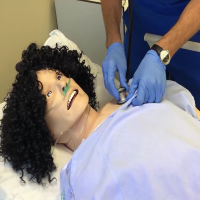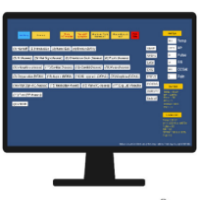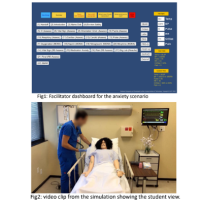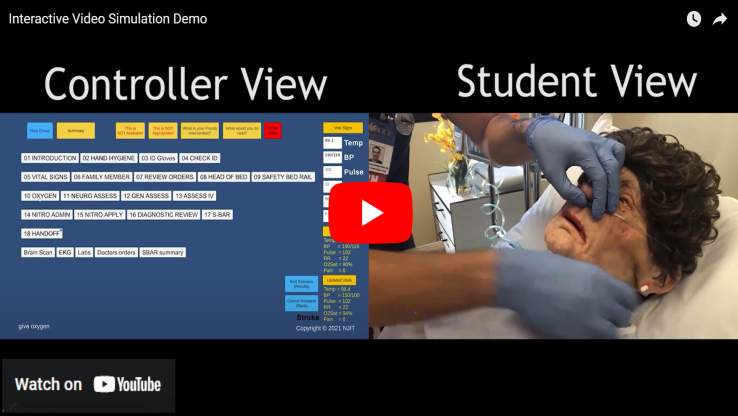Remote Interactive Video Simulation

Figure: The controller’s dashboard (left) shows the user interface that the facilitator uses to choose content displayed to the student. The student’s view on a second monitor can be shared with the students remotely.
Interdisciplinary collaborators:
- Dr. Laura Gonzalez (SentinelU, GA)
- Dr. Mindi Anderson, Dr. Desiree Diaz, Heidi Penny (College of Nursing at University of Central Florida, Orlando FL)
Motivation:
Healthcare simulation is an essential component for training nurses and doctors before they apply their skills on real patients. Typically, patient simulation occurs in a simulation center using standardized patients, Mannequins, or virtual simulation (e.g., computer screen, head-mounted display). During a simulation session, students interact with a simulated patient, followed by a debrief from the healthcare instructor. Interactivity is an essential element needed for simulation. Access to simulation centers is harder with social distancing during a pandemic and in remote areas regardless of the pandemic. During this pandemic, healthcare educators rushed to use pre-existing videos or had to record their own videos that they shared with their students to watch as a makeshift “simulation”. The problem is that these videos are not interactive which does not satisfy the interactivity requirement for simulation. Today, many nursing and medical students are watching videos passively without the opportunity to provide input (e.g., make decisions, assessments, interventions, communication…etc). Our innovation allows healthcare educators to add interactivity to their existing content to create new healthcare scenarios and remotely share that content with their students.
Innovation Description:
We developed the Interactive Video Simulation (IVS) software which provides healthcare educators (e.g., nurses, doctors) the power to create their own simulation scenarios using their own content (e.g., videos, images, text) and run the simulation remotely with their students. The software is content-independent, but it gives access to the educators to customize the scenarios with their own content in an easy way. Our software can run on a mac or a PC computer with a 2nd monitor attached. The 1st monitor has a dashboard with the buttons that the software generates for the scenario. The simulation facilitator (this is typically an instructor) controls the scenario by pressing those buttons. The 2nd screen shows the multimedia content that is triggered by the facilitator based on what the students choose to do next. The 2nd screen can be shared with remote students using any video conference software (e.g., Zoom) to display the responses while hiding the answers to avoid accidentally priming the students. When the facilitator clicks on buttons (e.g., videos, images, sounds…etc), a log is created to record the student’s choices and times. That facilitator can also provide feedback based on what the students do next. We are working on creating an immersive standalone version for trainees that they can use on a flat screen or on with a head mounted display with or without a facilitator.
Impact:
We interviewed 20 healthcare providers and educators from different institutions to assess their priorities for simulation, especially during the pandemic and similar emergencies. We found that they value the safety of remote simulation, the ability to customize content, adding interactivity to the simulation, and an easy-to-use software. They also stressed the importance of having a debrief and an opportunity for students to practice and experience the simulation. Our IVS software addresses all the points that the healthcare providers raised during the interviews.
We ran multiple studies at University of Central Florida using the IVS technology and we found that adding interactivity promotes teamwork, perception of authenticity, and higher levels of thinking. Also, the IVS software had high technology acceptance rate among students. The results were published in a peer reviewed journal and conferences (INACSL, IMSH).
Videos:
Publications & Presentations:
2023

Dahlia Musa, Laura Gonzalez, Heidi Penny, Salam Daher
Technology Acceptance and Authenticity in Interactive Simulation: Experimental Study Journal Article
In: Journal of Medical Education, vol. 9, pp. e40040, 2023.
@article{musa2023technology,
title = {Technology Acceptance and Authenticity in Interactive Simulation: Experimental Study},
author = {Dahlia Musa and Laura Gonzalez and Heidi Penny and Salam Daher},
url = {https://mededu.jmir.org/2023/1/e40040/},
doi = {doi:10.2196/40040},
year = {2023},
date = {2023-02-15},
urldate = {2023-02-15},
journal = {Journal of Medical Education},
volume = {9},
pages = {e40040},
abstract = {Background:
Remote and virtual simulations have gained prevalence during the COVID-19 pandemic as institutions maintain social distancing measures. Because of the challenges of cost, flexibility, and feasibility in traditional mannequin simulation, many health care educators have used videos as a remote simulation modality; however, videos provide minimal interactivity.
Objective:
In this study, we aimed to evaluate the role of interactivity in students’ simulation experiences. We analyzed students’ perceptions of technology acceptance and authenticity in interactive and noninteractive simulations.
Methods:
Undergraduate nursing students participated in interactive and noninteractive simulations. The interactive simulation was conducted using interactive video simulation software that we developed, and the noninteractive simulation consisted of passively playing a video of the simulation. After each simulation, the students completed a 10-item technology acceptance questionnaire and 6-item authenticity questionnaire. The data were analyzed using the Wilcoxon signed-rank test. In addition, we performed an exploratory analysis to compare technology acceptance and authenticity in interactive local and remote simulations using the Mann-Whitney U test.
Results:
Data from 29 students were included in this study. Statistically significant differences were found between interactive and noninteractive simulations for overall technology acceptance (P<.001) and authenticity (P<.001). Analysis of the individual questionnaire items showed statistical significance for 3 out of the 10 technology acceptance items (P=.002, P=.002, and P=.004) and 5 out of the 6 authenticity items (P<.001, P<.001, P=.001, P=.003, and P=.005). The interactive simulation scored higher than the noninteractive simulation in all the statistically significant comparisons. Our exploratory analysis revealed that local simulation may promote greater perceptions of technology acceptance (P=.007) and authenticity (P=.027) than remote simulation. Conclusions: Students’ perceptions of technology acceptance and authenticity were greater in interactive simulation than in noninteractive simulation. These results support the importance of interactivity in students’ simulation experiences, especially in remote or virtual simulations in which students’ involvement may be less active.},
keywords = {},
pubstate = {published},
tppubtype = {article}
}
Remote and virtual simulations have gained prevalence during the COVID-19 pandemic as institutions maintain social distancing measures. Because of the challenges of cost, flexibility, and feasibility in traditional mannequin simulation, many health care educators have used videos as a remote simulation modality; however, videos provide minimal interactivity.
Objective:
In this study, we aimed to evaluate the role of interactivity in students’ simulation experiences. We analyzed students’ perceptions of technology acceptance and authenticity in interactive and noninteractive simulations.
Methods:
Undergraduate nursing students participated in interactive and noninteractive simulations. The interactive simulation was conducted using interactive video simulation software that we developed, and the noninteractive simulation consisted of passively playing a video of the simulation. After each simulation, the students completed a 10-item technology acceptance questionnaire and 6-item authenticity questionnaire. The data were analyzed using the Wilcoxon signed-rank test. In addition, we performed an exploratory analysis to compare technology acceptance and authenticity in interactive local and remote simulations using the Mann-Whitney U test.
Results:
Data from 29 students were included in this study. Statistically significant differences were found between interactive and noninteractive simulations for overall technology acceptance (P<.001) and authenticity (P<.001). Analysis of the individual questionnaire items showed statistical significance for 3 out of the 10 technology acceptance items (P=.002, P=.002, and P=.004) and 5 out of the 6 authenticity items (P<.001, P<.001, P=.001, P=.003, and P=.005). The interactive simulation scored higher than the noninteractive simulation in all the statistically significant comparisons. Our exploratory analysis revealed that local simulation may promote greater perceptions of technology acceptance (P=.007) and authenticity (P=.027) than remote simulation. Conclusions: Students’ perceptions of technology acceptance and authenticity were greater in interactive simulation than in noninteractive simulation. These results support the importance of interactivity in students’ simulation experiences, especially in remote or virtual simulations in which students’ involvement may be less active.
2022

Dahlia Musa, Laura Gonzalez, Heidi Penny, Salam Daher
22nd International Meeting on Simulation in Healthcare (IMSH) , 2022.
@conference{musa2022interactive,
title = {Interactive Video Simulation for Healthcare Education: Technology Acceptance and Perceived Authenticity},
author = {Dahlia Musa and Laura Gonzalez and Heidi Penny and Salam Daher},
url = {https://drive.google.com/file/d/17gSZrkh1k3a2XbxCPmpbC-8wkrwzJthY/view?usp=share_link},
year = {2022},
date = {2022-06-01},
urldate = {2022-06-01},
booktitle = {22nd International Meeting on Simulation in Healthcare (IMSH) },
pages = {2},
keywords = {},
pubstate = {published},
tppubtype = {conference}
}
2021

Dahlia Musa, Laura Gonzalez, Heidi Penny, Salam Daher
Interactive Video Simulation for Remote Healthcare Learning Journal Article
In: Frontiers in Surgery: Healthcare Simulation and Online Learning, vol. 8, pp. 16, 2021.
@article{musa2021interactive,
title = {Interactive Video Simulation for Remote Healthcare Learning},
author = {Dahlia Musa and Laura Gonzalez and Heidi Penny and Salam Daher},
url = {https://www.frontiersin.org/articles/10.3389/fsurg.2021.713119/full},
doi = {10.3389/fsurg.2021.713119},
year = {2021},
date = {2021-08-10},
urldate = {2021-08-10},
journal = {Frontiers in Surgery: Healthcare Simulation and Online Learning},
volume = {8},
pages = {16},
abstract = {Simulation is an essential component of healthcare education as it enables educators to replicate clinical scenarios in a controlled learning environment. Simulation has traditionally been conducted in-person through the use of manikins, however, the COVID-19 pandemic has challenged the practice of manikin simulation. Social distance constraints were enforced during the pandemic to reduce the potential spread of the virus and as a result, many educators and students were denied physical access to their universities' simulation facilities. Healthcare educators sought remote alternatives to manikin simulation and many resorted to instructional videos to educate their learners. While the use of videos increases safety, passively watching videos lacks interactivity which is an important component of simulation learning. In response to these challenges, we developed an interactive video simulation software that uses educators' existing video content to conduct a simulation remotely, thereby promoting safety during the pandemic while also meeting the interactivity standards of best practice for healthcare simulation. In this paper, we compare the interactive video simulation to the current practice of watching non-interactive video of a simulation using the same content. We found that interactivity promotes higher order learning, increases teamwork and enhances the perception of authenticity. Additionally, the majority of participants demonstrated positive reception of the interactive simulation. The simulation software provides the safety desired of a remote simulation during the pandemic while also engaging students in interactive learning experiences.},
keywords = {},
pubstate = {published},
tppubtype = {article}
}

Laura Gonzalez, Salam Daher, Dahlia Musa, Heidi Penny
Interactive Video Simulation: A Remote Solution Conference
International Nursing Association for Clinical Simulation and Learning (INACSL), 2021.
@conference{gonzalez2021interactive,
title = {Interactive Video Simulation: A Remote Solution},
author = {Laura Gonzalez and Salam Daher and Dahlia Musa and Heidi Penny},
url = {https://drive.google.com/file/d/1kcS6uN4_x8XxGRsj5R8ffgTvAUByd_xM/view?usp=share_link},
year = {2021},
date = {2021-06-01},
urldate = {2021-06-01},
booktitle = {International Nursing Association for Clinical Simulation and Learning (INACSL)},
keywords = {},
pubstate = {published},
tppubtype = {conference}
}
